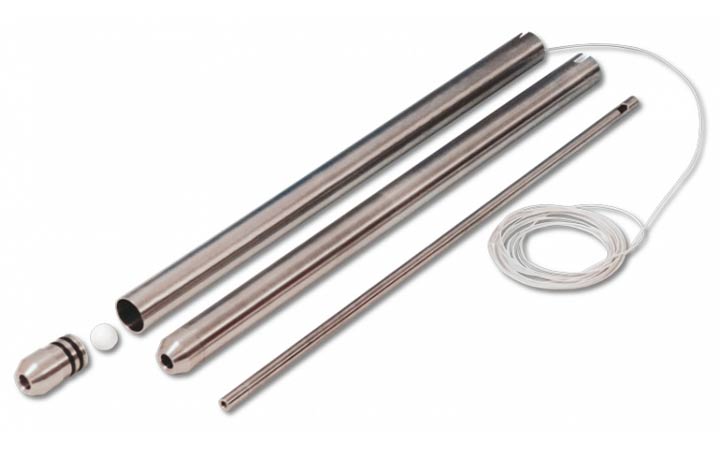- Simple and Cost Effective No expensive ancillary equipment is needed
- Range of Lengths and Diameters 0.5, 1, 1.5 and 2 inch diameters and standard lengths of 2, 3 and 4 ft available
- Ideal for aquifer profiling
- Stainless Steel Construction
Overview
Point source sampling is perfect for obtaining quality representative samples of groundwater from specific depths. Samples are collected as the water flows into the desired sampling point, which prevents purging and the disposal of purged water.
The Point Source Bailer can be used to profile an open borehole or screened well, collecting samples from specific levels and points of inflow. The Point Source Bailer has been designed so any water collected from different levels is never mixed which prevents sample contamination. It needs no ancillary equipment, making it ideal for point source sampling in hard to access locations. With a diameter of 0.5â?? (12.7mm) this miniature model is suitable for use in narrow tubes and direct push devices.
Method of Operation Firstly, the bailer is lowered on a support line to the desired depth. As the bailer is lowered, the ball valves open, allowing water to enter through the sampler.Once reaching the desired depth, the bailer is slowly raised which forces the ball valves closed. The bottom valve prevents the water from leaking and the top valve prevents the sample from mixing with water from the higher levels.
Once the bailer has reached the surface, the bailer can be opened via the top vent and carefully poured into a sample container. The Point Source Bailer should then be decontaminated for use with its next sample.
The Solinst Model 103 is recommended for use with the 429 Point Source Bailer. It is mounted on a convenient, easy-to-use reel, and has markings every 1ft or 5ft intervals (0.5m or 1m).
Manufactured by: Solinst
Model: Solinst 429 Point Source Bailer
Services offered for this product
- Sales
- Rental
- Installation
- Calibration
- Maintenance
- IoT Cloud Compatible
Applications
Borehole profiling
Well monitoring
Point sampling
Specification
| Bailer Capacity | |||
|---|---|---|---|
| O.D. inch | Capacity oz | O.D. mm | Capacity ml |
| 2 ft Length (610 mm) | |||
| 0.5 | 1.7 | 12.7 | 50 |
| 1.0 | 7 | 25.4 | 210 |
| 1.5 | 13 | 38.1 | 390 |
| 2.0 | 29 | 50.8 | 850 |
| 3 ft Length (910 mm) | |||
| 0.5 | 2.7 | 12.7 | 80 |
| 1.0 | 11 | 25.4 | 330 |
| 1.5 | 23 | 38.1 | 680 |
| 2.0 | 47 | 50.8 | 1390 |
| 4 ft Length (1220 mm) | |||
| 0.5 | 3.7 | 12.7 | 110 |
| 1.0 | 15 | 25.4 | 450 |
| 1.5 | 33 | 38.1 | 970 |
| 2.0 | 65 | 50.8 | 1930 |
| Point Source Bailers come in standard lengths of 2ft. (610 mm), 3 ft. (910 mm), or 4 ft. (1220 mm) | |||
Related products
FAQ's
- Lower cost for instrumentation
- Faster sampling
- Little/no water agitation
- Simple
- Allows sampling in wells with small water volumes
- Variety of sample sizes
- Can be used to identify stratified layers of water chemistry in wells/boreholes


